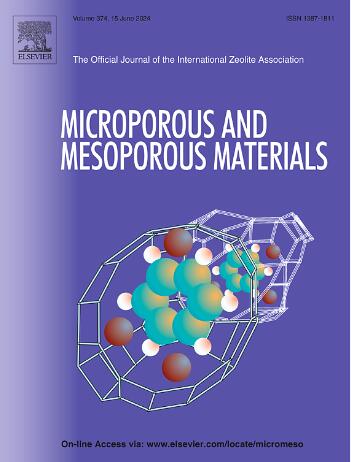Tailoring catalyst support with bicontinuous concentric lamellar morphology for dry reforming of methane
IF 4.8
3区 材料科学
Q1 CHEMISTRY, APPLIED
引用次数: 0
Abstract
Since the utilization of greenhouse gases has been an important topic for the last decade, a great effort has been made to find a way to ameliorate this utilization. Dry reforming of methane (DRM) has gained much attention due to its ability to decrease greenhouse gas emissions and generate valuable syngas. In this study, unique material with bicontinuous concentric lamellar (bcl) morphology has been synthesized and employed as catalyst support for DRM reaction. Ni/bcl-Silica and Ni/bcl-AAs catalysts with bcl morphology were successfully synthesized and characterized using XRD, SEM, TEM, FTIR, N2 adsorption, and CO2-TPD analysis. In the DRM reaction, the Ni/bcl-AAs catalyst demonstrated significantly better performance, achieving 90 % CH4 selectivity and 77 % CO2 conversion, compared to Ni/bcl-Silica. This superior performance is attributed to the bcl morphology, which provides a high surface area and improved accessibility of reactants to the active metal sites, thereby enhancing catalytic efficiency. Moreover, the presence of Al content in Ni/bcl-AAs composition can enhance the basicity of the Ni/bcl-AAs catalyst. The synergistic effect between the high surface area and basic sites resulted in a good performance in DRM reaction.

求助全文
约1分钟内获得全文
求助全文
来源期刊

Microporous and Mesoporous Materials
化学-材料科学:综合
CiteScore
10.70
自引率
5.80%
发文量
649
审稿时长
26 days
期刊介绍:
Microporous and Mesoporous Materials covers novel and significant aspects of porous solids classified as either microporous (pore size up to 2 nm) or mesoporous (pore size 2 to 50 nm). The porosity should have a specific impact on the material properties or application. Typical examples are zeolites and zeolite-like materials, pillared materials, clathrasils and clathrates, carbon molecular sieves, ordered mesoporous materials, organic/inorganic porous hybrid materials, or porous metal oxides. Both natural and synthetic porous materials are within the scope of the journal.
Topics which are particularly of interest include:
All aspects of natural microporous and mesoporous solids
The synthesis of crystalline or amorphous porous materials
The physico-chemical characterization of microporous and mesoporous solids, especially spectroscopic and microscopic
The modification of microporous and mesoporous solids, for example by ion exchange or solid-state reactions
All topics related to diffusion of mobile species in the pores of microporous and mesoporous materials
Adsorption (and other separation techniques) using microporous or mesoporous adsorbents
Catalysis by microporous and mesoporous materials
Host/guest interactions
Theoretical chemistry and modelling of host/guest interactions
All topics related to the application of microporous and mesoporous materials in industrial catalysis, separation technology, environmental protection, electrochemistry, membranes, sensors, optical devices, etc.
 求助内容:
求助内容: 应助结果提醒方式:
应助结果提醒方式:


